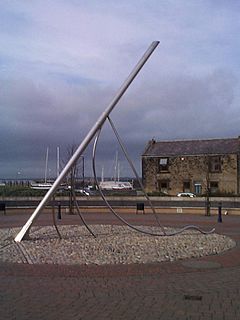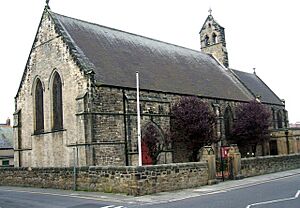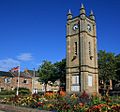Amble facts for kids
Quick facts for kids Amble |
|
|---|---|
 The sundial in the town square |
|
| Population | 6,025. (2011) |
| OS grid reference | NU267041 |
| Civil parish |
|
| Unitary authority |
|
| Ceremonial county | |
| Region | |
| Country | England |
| Sovereign state | United Kingdom |
| Post town | MORPETH |
| Postcode district | NE65 |
| Dialling code | 01665 |
| Police | Northumbria |
| Fire | Northumberland |
| Ambulance | North East |
| EU Parliament | North East England |
| UK Parliament |
|
Amble is a friendly town located on the North Sea coast in Northumberland, England. It sits right where the River Coquet meets the sea. From its beaches, you can see Coquet Island nearby. In 2011, about 6,025 people lived in the area known as Amble by the Sea.
Contents
What's in a Name?
The name Amble has a couple of interesting ideas about where it came from. One idea is that it comes from an old Irish language term, Am Béal, which means "tidal inlet." This might be because Irish missionaries were in the area long ago.
Another idea, from a scholar named Eilert Ekwall, suggests it comes from an old English name, Amma/Anna bile. This means "Amma's/Anna's headland," referring to a piece of land sticking out into the sea. People have been using names like Amble since at least the year 1203.
Amble's Past: A Coal Town
Amble has a long history, with signs of ancient burials found from the 1880s. These included urns and spearheads, some showing that people were cremated.
For a long time, people knew there was coal along the coast near Amble. But it was hard to dig up and move it cheaply. In the 1600s, there was a plan to use Amble as a port for coal and salt, but it didn't work out. Other areas like the River Tyne and River Wear were better for coal at that time.
Things changed as coal became harder to find in those other places. By the late 1600s, coal was being dug up and shipped from Amble. The town really grew in the 1800s when more coal mines opened. New railway lines made it easier to bring coal to Amble, turning it into a busy port for exporting coal by sea. Before this, Amble was just a small village.
The harbour in Amble was the smallest of the ports that served the coalfields. In 1837, a group called the Warkworth Harbour Commission was set up to make improvements. They built large walls called breakwaters to protect the harbour, finishing them in 1849.
Instead of building docks, the railway led to the creation of "coal staithes," which were special platforms for loading coal onto ships. By 1914, over 500,000 tons of coal were shipped from Amble each year.
The railway line to Amble opened in 1849, first for coal. Passenger trains started in 1879 but stopped in 1930. All coal traffic ended in 1969, and the railway line closed completely.
Other industries also grew, like sea fishing and building or repairing ships. Traditional Northumbrian fishing boats called cobles had used the natural harbour for centuries. One local company, J. & J. Harrison, even started putting engines in cobles in 1870.
Sadly, on December 1, 1943, during World War II, a Royal Air Force plane crashed near Amble. Six of the seven crew members died, along with five children on the ground. A housing area built in 1997 has streets named after the children who lost their lives.
Amble Today: A Coastal Community
Today, Amble is a pleasant small town. Some older buildings still stand, like St Cuthbert's Church, built in 1870, and some Victorian houses. There's even a small piece of a medieval manor house wall on High Street!
The fishing industry is still important in Amble, though with fewer boats. There's also a small marine industry that builds and fixes yachts and other pleasure craft. An industrial area has some businesses, but many units are empty. The town has faced challenges with job losses from nearby factories closing.
The Royal National Lifeboat Institution (RNLI) has a station in Amble. They have two lifeboats, including a modern Shannon Class boat. Lifeboats have been helping people in Amble since 1842, saving many lives over the years.
Community Spirit and Growth
Amble has been working to improve itself for many years. In the 1960s, when coal mining declined, many people lost their jobs. The town faced high unemployment.
The Amble Development Trust, a charity started in 1994, works with others to make the town better. They've helped improve the main shopping street, Queen Street. Their work has won awards for helping to regenerate the town.
Recently, new homes have been built, and a new hotel called the Amble Inn opened in 2019, creating new jobs. The Trust also publishes The Ambler, a free community newspaper and website run by volunteers since 2000. It's delivered to every home and business in town!
Amble's People
In 1831, Amble had a population of 247 people. By 1848, it had grown to 724, and by 1851, it was 1,040. The town continued to grow as industries developed.
How Amble is Governed
Long ago, Amble was part of an area controlled by the priors (leaders) of Tynemouth. In 1539, it became part of the Crown's land.
Over time, how Amble was governed changed. In 1878, the Amble Local Government District was set up to manage the town. This was later replaced by the Amble Urban District Council in 1895. In 1974, Amble became part of the Alnwick district.
In 2009, the local government in Northumberland changed again. Amble is now part of the larger unitary authority of Northumberland, which is based in Morpeth.
Today, Amble has its own electoral ward, which includes nearby Hauxley.
Amble's Weather
Being in the British Isles, Amble has a maritime climate. This means it has cool summers and mild winters. The nearest weather station is at Boulmer, about nine miles north.
| Climate data for Boulmer 23m asl, 1971–2000 | |||||||||||||
|---|---|---|---|---|---|---|---|---|---|---|---|---|---|
| Month | Jan | Feb | Mar | Apr | May | Jun | Jul | Aug | Sep | Oct | Nov | Dec | Year |
| Record high °C (°F) | 15.0 (59.0) |
16.1 (61.0) |
19.4 (66.9) |
23.5 (74.3) |
24.5 (76.1) |
28.5 (83.3) |
28.2 (82.8) |
31.0 (87.8) |
26.7 (80.1) |
21.4 (70.5) |
18.0 (64.4) |
15.2 (59.4) |
31.0 (87.8) |
| Mean daily maximum °C (°F) | 6.7 (44.1) |
6.9 (44.4) |
8.8 (47.8) |
10.1 (50.2) |
12.5 (54.5) |
15.6 (60.1) |
17.9 (64.2) |
18.1 (64.6) |
15.9 (60.6) |
12.8 (55.0) |
9.3 (48.7) |
7.4 (45.3) |
11.9 (53.4) |
| Mean daily minimum °C (°F) | 1.3 (34.3) |
1.5 (34.7) |
2.5 (36.5) |
3.7 (38.7) |
5.9 (42.6) |
8.6 (47.5) |
10.8 (51.4) |
10.8 (51.4) |
9.1 (48.4) |
6.7 (44.1) |
3.7 (38.7) |
2.2 (36.0) |
5.6 (42.1) |
| Record low °C (°F) | −12.0 (10.4) |
−8.9 (16.0) |
−10 (14) |
−3.9 (25.0) |
−1.5 (29.3) |
0.9 (33.6) |
3.9 (39.0) |
4.5 (40.1) |
1.0 (33.8) |
−1.8 (28.8) |
−6.2 (20.8) |
−8.8 (16.2) |
−12 (10) |
| Average precipitation mm (inches) | 59.0 (2.32) |
41.4 (1.63) |
46.7 (1.84) |
49.2 (1.94) |
48.0 (1.89) |
53.4 (2.10) |
47.6 (1.87) |
62.1 (2.44) |
54.7 (2.15) |
58.1 (2.29) |
67.2 (2.65) |
63.6 (2.50) |
651.0 (25.63) |
| Mean monthly sunshine hours | 62.6 | 79.4 | 121.5 | 152.7 | 194.1 | 193.8 | 186.3 | 178.9 | 135.6 | 105.7 | 76.5 | 53.3 | 1,540.4 |
| Source: MetOffice | |||||||||||||
Getting Around Amble
By Road
Amble is on the A1068 road, which runs along the coast. It's also close to the main A1 road, making it easy to reach cities like Newcastle upon Tyne (about 30 miles south) and Edinburgh (about 80 miles north).
By Rail
The main East Coast Main Line railway, connecting Edinburgh and London, runs near Amble. You can catch trains from Alnmouth for Alnwick Station or Widdrington Station.
By Air
Newcastle Airport is less than an hour's drive away. It has daily flights to London and regular flights to other places in the UK, Europe, Africa, and North America.
Amble in the Media
Television
Local news and TV shows for Amble come from BBC North East and Cumbria and ITV Tyne Tees.
Radio
You can listen to local radio stations like BBC Radio Newcastle, Heart North East, and Koast Radio, which is a community station.
Newspapers
The town has a local newspaper called the Northumberland Gazette. There's also The Ambler, a free community paper run by volunteers since 2000.
Fun Things to Do in Amble
Amble is right next to the beautiful Northumberland Coast Area of Outstanding Natural Beauty. It's also close to nature reserves at Cresswell, Druridge, and Hauxley, which are great for seeing wildlife.
The town has places to stay like a caravan park, guest houses, and bed and breakfasts. The Braid, part of the harbour, now has a modern marina for boats.
Nearby Coquet Island is a special home for many nesting sea birds, including cute puffins and the rare Roseate tern. You can't go onto the island, but you can take boat trips around it to see the birds. Amble even has a "Puffin Festival" in May when the puffins are most active!
The Friendliest Port
Amble is known for being a very friendly place! In the 1930s, when the famous ship RMS Mauretania was on its last journey to be taken apart, Amble sent a telegram saying it was "still the finest ship on the seas." The Mauretania replied, calling Amble "the last and kindliest port in England."
Famous People from Amble
- William Rochester Pape (1831 - 1923) - An English gunsmith who invented a special system for gun barrels and held the first dog show in Great Britain.
- Sir James Calvert Spence (1892–1954) - A well-known expert in nutrition and children's health.
- Professor Fred Taylor (1934 - 2021) - A famous physicist who worked at Oxford University and NASA's Jet Propulsion Laboratory.
- John Angus (1938 - 2021) - A footballer who played for Burnley F.C. and the England national team.
- Luke James (1994 -living) - A footballer who plays for Peterborough United.
Gallery











